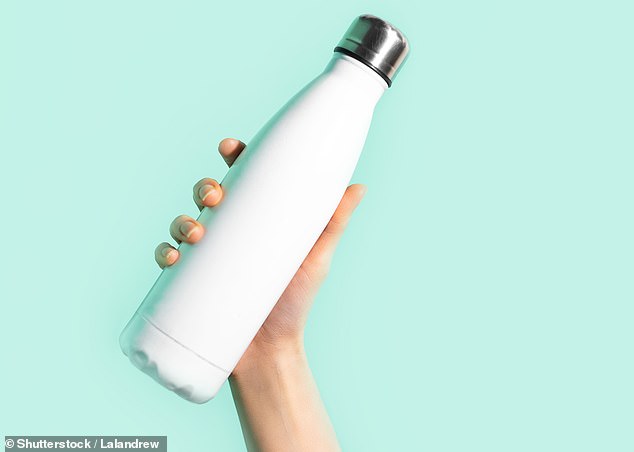Woman with mysterious flu-like symptoms discovers that unlikely everyday things can make her sick
A woman who suffered from mysterious cold symptoms for almost a year claims her reusable water bottle made her sick.
Karyn Smith Wilson of Elmhurst, Illinois, went back to the gym every time she recovered, but “within a week the disease returned.”
She would then be struck by fever, pain, breathing difficulties and fatigue.
Through the process of elimination, Ms. Wilson realized that the only thing that had changed in her routine was a new metal water bottle that she had purchased to use while exercising.
Doctors said DailyMail.com’s metal water bottles sometimes contained lead and cadmium, highly toxic metals and other chemicals linked to health problems.
They are also prone to bacterial buildup and research shows that few people wash them, making them a potential carrier of germs.
Karyn Smith Wilson from Elmhurst, Illinois, reveals in a TikTok how she had flu-like symptoms for six to nine months, which she attributed to using a metal water bottle
Wilson talks about her ordeal in a TikTok video, further noting that a future incident reaffirmed her suspicions.
She revealed: ‘I’ve been keeping (the bottle) hoping to get it tested one day. (Then) I accidentally used it one day, months later, on a bike ride.
“The next day I had the same old symptoms.”
Speaking to DailyMail.com, internationally recognized and respected food policy expert Darin Detwiler confirmed that metal water bottles “could potentially make someone sick due to contamination or even poor quality materials.”
He added: ‘In rare cases they may contain harmful substances such as lead or cadmium, which can leach into the water.
“Additionally, improper sanitation can lead to bacteria buildup, especially in crevices or straws, contributing to illness.”
‘Plastic bottles have also raised concerns about chemicals such as BPA, which can leach into liquids, and improper cleaning of either material can harbor bacteria or mold.’
After being reminded of the symptoms caused by the metal water bottle, Karyn never used it again and threw it away.
She confirmed in the comments section that the bottle came from homeware brand Oggi, which sells goods through Amazon and other sites.
The California native said she decided to share her story in an effort to warn others, and her video has since been viewed more than 1 million times.
The FDA Comments that chronic lead exposure is associated with renal dysfunction, hypertension and neurocognitive effects.
Meanwhile, consuming trace amounts of cadmium can cause stomach irritation, abdominal cramps, nausea, vomiting and diarrhea.

The content creator reveals that she now only uses glass water bottles

Speaking to DailyMail.com, food policy expert Darin Detwiler confirmed that metal water bottles ‘could potentially make someone sick due to contamination or poor quality materials’
Exposure to the chemical element through inhalation can also lead to respiratory diseases and over long periods of time – such as from cigarette smoking or through occupational exposure – it has been ‘linked to many different types of cancer’.
Earlier this year, the maker of the popular Stanley Cup was hit with multiple lawsuits after the company admitted that its viral cups contained some amount of lead.
Four California complainants said the company falsely advertised its cups as “BPA-free” but failed to warn the public that lead is a “key ingredient” in the vacuum packaging, in a Feb. 1 filing in which 70 million dollars was demanded.
They claim they purchased Stanley cups before the company’s announcement in January and claim they would not have purchased them if they knew they contained lead.
‘Our manufacturing process currently uses an industry standard pellet to seal the vacuum insulation at the base of our products; the sealing material contains some lead,” Stanley said on the support page.
‘Once sealed, this area is covered with a durable stainless steel layer, making it inaccessible to consumers. You can be assured that lead is not present on the surface of any Stanley product that comes into contact with the consumer, nor on the contents of the product.”
